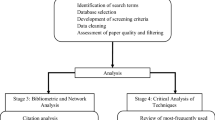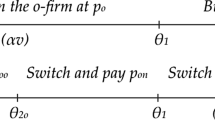Abstract
In this paper, we develop a supply chain network game theory model with product differentiation, possible outsourcing of production and distribution, and quality and price competition. The original firms compete with one another in terms of in-house quality levels and product flows, whereas the contractors, aiming at maximizing their own profits, engage in competition for the outsourced production and distribution in terms of prices that they charge and their quality levels. The solution of the model provides each original firm with its optimal in-house quality level as well as its optimal in-house and outsourced production and shipment quantities that minimize the total cost and the weighted cost of disrepute, associated with lower quality levels and the impact on a firm’s reputation. The governing equilibrium conditions of the model are formulated as a variational inequality problem. An algorithm, which provides a discrete-time adjustment process and tracks the evolution of the product flows, quality levels, and prices over time, is proposed and convergence results given. Numerical examples are provided to illustrate how such a supply chain network game theory model can be applied in practice. The model is relevant to products ranging from pharmaceuticals to fast fashion to high technology products.






Similar content being viewed by others
References
AAFA (American Apparel and Footwear Association). (2012). AAFA releases apparelStats 2012 report. https://www.wewear.org/aafa-releases-apparelstats-2012-report/. Accessed July 13, 2013.
Acharyya, R. (2005). Consumer targeting under quality competition in a liberalized vertically differentiated market. Journal of Economic Development, 30(1), 129–150.
Allen, L. (2003). Legal cloud hangs over buyers. Australian Financial Review, May 1, 2003.
Apple. (2012). Apple reports fourth quarter results. http://www.apple.com/pr/library/2012/10/25Apple-Reports-Fourth-Quarter-Results.html. Accessed August 1, 2013.
ASQC (American Society for Quality Control). (1971). Quality costs, what and how (2nd ed.). Milwaukee, WI: ASQC Quality Press.
Banker, R. D., Khosla, I., & Sinha, K. K. (1998). Quality and competition. Management Science, 44(9), 1179–1192.
BBC. (2013). 2013 Bangladesh building collapse death toll passes 500. http://www.bbc.co.uk/news/world-asia-22394094. Accessed July 13, 2013.
Bertrand, J. (1883). Theorie mathematique de la richesse sociale. Journal des Savants, 499–508.
Brekke, K. R., Siciliani, L., & Straume, O. R. (2010). Price and quality in spatial competition. Regional Science and Urban Economics, 40, 471–480.
BS (British Standards) 6143: Part 2. (1990). Guide to determination and use of quality-related costs. London: British Standards Institution.
Coase, R. H. (1937). The nature of the firm. Economica, 4, 386–405.
Cockburn, I. M. (2004). The changing structure of the pharmaceutical industry. Health Affairs, 23(1), 10–22.
Cournot, A. A. (1838). Researches into the mathematical principles of the theory of wealth, English translation (p. 1987). London: MacMillan.
Cruz, J. M., Nagurney, A., & Wakolbinger, T. (2006). Financial engineering of the integration of global supply chain networks and social networks with risk management. Naval Research Logistics, 53, 674–696.
Dafermos, S. C., & Sparrow, F. T. (1969). The traffic assignment problem for a general network. Journal of Research of the National Bureau of Standards, 73B, 91–118.
Dixit, A. (1979). Quality and quantity competition. Review of Economic Studies, 46(4), 587–599.
Dupuis, P., & Nagurney, A. (1993). Dynamical systems and variational inequalities. Annals of Operations Research, 44, 9–42.
Economy In Crisis. (2010). U.S. pharmaceutical outsourcing threat. http://economyincrisis.org/content/outsourcing-americas-medicine. Accessed September 8, 2013.
Floden, J., Barthel, F., & Sorkina, E. (2010). Factors influencing transport buyer’s choice of transport service: A European literature review. In Proceedings of the 12th WCTR conference, July 11–15, Lisbon, Portugal.
Gabay, D., & Moulin, H. (1980). On the uniqueness and stability of Nash equilibria in noncooperative games. In A. Bensoussan, P. Kleindorfer, & C. S. Tapiero (Eds.), Applied stochastic control in econometrics and management science (pp. 271–294). Amsterdam: North-Holland.
Gal-or, E. (1983). Quality and quantity competition. Bell Journal of Economics, 14, 590–600.
Gan, D., & Litvinov, E. (2003). Energy and reserve market designs with explicit consideration to lost opportunity costs. IEEE Transactions on Power Systems, 18(1), 53–59.
Grabowski, H., & Vernon, J. (1990). A new look at the returns and risks to pharmaceutical R&D. Management Science, 36(7), 804–821.
Heshmati, A. (2003). Productivity growth, efficiency and outsourcing in manufacturing and service industries. Journal of Economic Surveys, 17(1), 79–112.
Johnson, J. P., & Myatt, D. P. (2003). Multiproduct quality competition: Fighting brands and product line pruning. American Economic Review, 93(3), 748–774.
Kaya, M., & Özer, Ö. (2009). Quality risk in outsourcing: Noncontractible product quality and private quality cost information. Naval Research Logistics, 56, 669–685.
Klum, E. (2007). Volvo to outsource auto components from India. http://www.articlesbase.com/cars-articles/volvo-to-outsource-auto-components-from-india-223056.html. Accessed August 15, 2013.
Lederer, P. J., & Rhee, S. K. (1995). Economics of total quality management. Journal of Operations Management, 12, 353–367.
Liu, Z., & Nagurney, A. (2009). An integrated electric power supply chain and fuel market network framework: Theoretical modeling with empirical analysis for New England. Naval Research Logistics, 56, 600–624.
Liu, Z., & Nagurney, A. (2013). Supply chain networks with global outsourcing and quick-response production under demand and cost uncertainty. Annals of Operations Research, 208(1), 251–289.
Mankiw, G. N. (2011). Principles of microeconomics (6th ed.). Mason, OH: South-Western, Cengage Learning.
McEntegart, J. (2010). Apple, Dell, HP comment on Foxconn suicides. http://www.tomshardware.com/news/Foxconn-Suicide,10525.html. Accessed September 5, 2013.
Mussa, M., & Rosen, S. (1978). Monopoly and product quality. Journal of Economic Theory, 18, 301–317.
Nagurney, A. (1999). Network economics: A variational inequality approach. Dordrecht: Kluwer.
Nagurney, A. (2006). Supply chain network economics: Dynamics of prices, flows, and profits. Cheltenham: Edward Elgar.
Nagurney, A. (2010). Formulation and analysis of horizontal mergers among oligopolistic firms with insights into the merger paradox: A supply chain network perspective. Computational Management Science, 7, 377–410.
Nagurney, A., Dupuis, P., & Zhang, D. (1994). A dynamical systems approach for network oligopolies and variational inequalities. Annals of Regional Science, 28, 263–283.
Nagurney, A., & Li, D. (2014). A dynamic network oligopoly model with transportation costs, product differentiation, and quality competition. Computational Economics, 44(2), 201–229.
Nagurney, A., Li, D., & Nagurney, L. S. (2013a). Pharmaceutical supply chain networks with outsourcing under price and quality competition. International Transactions in Operational Research, 20(6), 859–888.
Nagurney, A., Yu, M., Masoumi, A. H., & Nagurney, L. S. (2013b). Networks against time: Supply chain analytics for perishable products. New York: Springer Business + Science Media.
Nagurney, A., & Zhang, D. (1996). Projected dynamical systems and variational inequalities with applications. Boston, MA: Kluwer.
Nagurney, A., & Zhang, D. (1997). Projected dynamical systems in the formulation, stability analysis, and computation of fixed-demand traffic network equilibria. Transportation Science, 31(2), 147–158.
Nash, J. F. (1950). Equilibrium points in n-person games. Proceedings of the National Academy of Sciences of the United States of America (PNAS), 36, 48–49.
Nash, J. F. (1951). Noncooperative games. Annals of Mathematics, 54, 286–298.
New Oxford American Dictionary (3rd ed.). A. Stevenson & C. A. Lindberg (Eds.). Oxford: Oxford University Press, 2010.
Nystedt, D. (2010). Kindle screen maker will increase capacity to meet demand. http://www.computerworld.com/s/article/9179759. Accessed August 1, 2013.
Palmer, S., & Raftery, J. (1999). Economics notes: Opportunity cost. BMJ. British Medical Journal, 318(7197), 1551–1552.
Payne, J. W., Bettman, J. R., & Luce, M. F. (1996). When time is money: Decision behavior under opportunity-cost time pressure. Organizational Behavior and Human Decision Processes, 66(2), 131–152.
Porteus, E. L. (1986). Optimal lot sizing, process quality improvement and setup cost reduction. Operations Research, 34(1), 137–144.
Rawson, C. (2012). Why Apple’s products are “designed in California” but “assembled in China”. http://www.tuaw.com/2012/10/22/why-apples-products-are-designed-in-california-but-assembled/. Accessed August 1, 2013.
Rogerson, W. P. (1988). Price advertising and the deterioration of product quality. The Review of Economic Studies, 55(2), 215–229.
Ronnen, U. (1991). Minimum quality standards, fixed costs, and competition. Rand Journal of Economics, 22(4), 490–504.
Sandoval-Chavez, D. A., & Beruvides, M. G. (1998). Using opportunity costs to determine the cost of quality: A case study in a continuous-process industry. The Engineering Economist, 43, 107–124.
Saxin, B., Lammgard, C., & Floden, J. (2005). Meeting the demand for goods transports—Identification of flows and needs among Swedish companies. In NOFOMA 2005. Copenhagen, Denmark.
Sheshinski, E. (1976). Price quality and quantity regulation in monopoly situation. Economica, 43, 127–137.
Sink, H. L., & Langley, J. C, Jr. (1997). A managerial framework for the acquisition of third party logistics services. Journal of Business Logistics, 18(2), 163–189.
Spence, A. M. (1975). Monopoly, quality, and regulation. The Bell Journal of Economics, 6(2), 417–429.
The New York Times. (2002). Taiwan maker of notebook PC’s thrives quietly. http://www.nytimes.com/2002/03/25/business/taiwan-maker-of-notebook-pc-s-thrives-quietly.html. Accessed September 1, 2013.
The New York Times. (2007). Mattel recalls 19 million toys sent from China. http://www.nytimes.com/2007/08/15/business/worldbusiness/15imports.html?pagewanted=all. Accessed June 24, 2013.
Topolsky, J. (2010). Foxconn’s Tegra 2-powered Android tablet hands-on. http://www.engadget.com/2010/05/19/foxconns-tegra-2-powered-android-tablet-hands-on-video/. Accessed August 1, 2013.
Xiao, T., Xia, Y., & Zhang, G. P. (2014). Strategic outsourcing decisions for manufacturers competing in product quality. IIE Transactions, 46(4), 313–329.
Yahoo. (2012). Wal-Mart, Disney clothes found in Bangladesh fire. http://finance.yahoo.com/news/wal-mart-disney-clothes-found-bangladesh-fire-203417088-finance.html. Accessed July 13, 2013.
Yahoo. (2013a). World automotive component outsourcing market to hit US \({\$}855\) billion by 2016. http://news.yahoo.com/world-automotive-component-outsourcing-market-hit-us-855-080831299.html. Accessed August 15, 2013.
Yahoo. (2013b). Bangladesh collapse search over; death toll 1,127. http://news.yahoo.com/bangladesh-collapse-search-over-death-toll-1-127-122554495.html. Accessed July 13, 2013.
Yu, M., & Nagurney, A. (2013). Competitive food supply chain networks with application to fresh produce. European Journal of Operational Research, 224(2), 273–282.
Zhou, Y. (2007). Opportunities in biopharmaceutical outsourcing to China. BioProcess International, 5(1), 16–23.
Acknowledgments
This research was supported, in part, by the National Science Foundation (NSF) grant CISE #1111276, for the NeTS: Large: Collaborative Research: Network Innovation Through Choice project awarded to the University of Massachusetts Amherst. The first author also acknowledges support from the Visiting Professor Programme at the School of Business, Economics and Law at the University of Gothenburg. Support from the John F. Smith Memorial Fund at the Isenberg School of Management at the University of Massachusetts is also acknowledged. We acknowledge helpful comments and suggestions in the reviewing process of the original paper.
Author information
Authors and Affiliations
Corresponding author
Rights and permissions
About this article
Cite this article
Nagurney, A., Li, D. A supply chain network game theory model with product differentiation, outsourcing of production and distribution, and quality and price competition. Ann Oper Res 226, 479–503 (2015). https://doi.org/10.1007/s10479-014-1692-5
Published:
Issue Date:
DOI: https://doi.org/10.1007/s10479-014-1692-5




